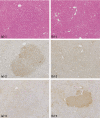Characteristic upregulation of glucose-regulated protein 78 in an early lesion negative for hitherto established cytochemical markers in rat hepatocarcinogenesis
- PMID: 22272003
- PMCID: PMC3234602
- DOI: 10.1293/tox.22.281
Characteristic upregulation of glucose-regulated protein 78 in an early lesion negative for hitherto established cytochemical markers in rat hepatocarcinogenesis
Abstract
Previously, we reported α(2)-macroglobulin (α(2)M) to be a novel marker characteristic of rat hepatocellular preneoplastic and neoplastic lesions negative for hitherto well-established markers. In the present study, we further examined other candidate markers with specificity for the same type of lesions. Glutathione S-transferase-placental form (GST-P)-negative hepatocellular altered foci (HAF) were generated using a two-stage (initiation and promotion) carcinogenesis protocol with N,N-diethylnitrosamine (DEN) and either Wy-14,643 or clofibrate, two peroxisome proliferators. Microarray analysis using total RNAs isolated from laser-microdissected GST-P-negative HAF (amphophilic cell foci) and adjacent normal tissues was conducted along with immunohistochemistry and real-time RT-PCR. Staining for glucose-regulated protein 78 (GRP78) was detected in GST-P-negative HAF and hepatocellular adenomas, and slightly increased GRP78 mRNA expression was observed in the lesions by real-time RT-PCR analysis. Thus, an early increase of GRP78 expression in hepatocarcinogenesis is likely a feature of the amphophilic subset of HAF.
Keywords: glucose-regulated protein 78; molecular marker; preneoplastic lesion; rat hepatocarcinogenesis; α2-macroglobulin.
Figures



Similar articles
-
alpha(2)-Macroglobulin: a novel cytochemical marker characterizing preneoplastic and neoplastic rat liver lesions negative for hitherto established cytochemical markers.Am J Pathol. 2004 Nov;165(5):1479-88. doi: 10.1016/s0002-9440(10)63406-2. Am J Pathol. 2004. PMID: 15509519 Free PMC article.
-
Immunohistochemical demonstration of the gap junctional protein connexin 32 and proliferating cell nuclear antigen in glutathione S-transferase placental form-negative lesions of rat liver induced by diethylnitrosamine and clofibrate.Toxicol Pathol. 1996 Nov-Dec;24(6):690-5. doi: 10.1177/019262339602400603. Toxicol Pathol. 1996. PMID: 8994295
-
Involvement of multiple cell cycle aberrations in early preneoplastic liver cell lesions by tumor promotion with thioacetamide in a two-stage rat hepatocarcinogenesis model.Exp Toxicol Pathol. 2013 Nov;65(7-8):979-88. doi: 10.1016/j.etp.2013.01.012. Epub 2013 Mar 7. Exp Toxicol Pathol. 2013. PMID: 23474136
-
Specific expression of glutathione S-transferase Pi forms in (pre)neoplastic tissues: their properties and functions.Tohoku J Exp Med. 1992 Oct;168(2):97-103. doi: 10.1620/tjem.168.97. Tohoku J Exp Med. 1992. PMID: 1306337 Review.
-
The quantitation of altered hepatic foci during multistage hepatocarcinogenesis in the rat: transforming growth factor alpha expression as a marker for the stage of progression.Cancer Lett. 1995 Jun 29;93(1):73-83. doi: 10.1016/0304-3835(95)03789-Y. Cancer Lett. 1995. PMID: 7600545 Review.
Cited by
-
Alpha-2-Macroglobulin in Inflammation, Immunity and Infections.Front Immunol. 2021 Dec 14;12:803244. doi: 10.3389/fimmu.2021.803244. eCollection 2021. Front Immunol. 2021. PMID: 34970276 Free PMC article. Review.
References
-
- Ito N, Hananouchi M, Sugihara S, Shirai T, Tsuda H, Fukushima S, Nagasaki H. Reversibility and irreversibility of liver tumors in mice induced by the α isomer of 1,2,3,4,5,6-hexachlorocyclohexane. Cancer Res. 1976;36:2227–2234. - PubMed
-
- Moore MA, Hacker HJ, Bannasch P. Phenotypic instability in focal and nodular lesions induced in a short-term system in the rat liver. Carcinogenesis. 1983;4:595–603. - PubMed
-
- Tatematsu M, Nagamine Y, Farber E. Redifferentiation as a basis for remodeling of carcinogen-induced hepatocyte nodules to normal appearing liver. Cancer Res. 1983;43:5049–5058. - PubMed
-
- Takahashi S, Lombardi B, Shinozuka H. Progression of carcinogen-induced foci of gamma-glutamyltranspeptidase-positive hepatocytes to hepatomas in rats fed a choline-deficient diet. Int J Cancer. 1982;29:445–450. - PubMed
-
- Scherer E, Emmelot P. Kinetics of induction and growth of precancerous liver-cell foci, and liver tumour formation by diethylnitrosamine in the rat. Eur J Cancer. 1975;11:689–696. - PubMed
LinkOut - more resources
Full Text Sources
Research Materials
Miscellaneous
